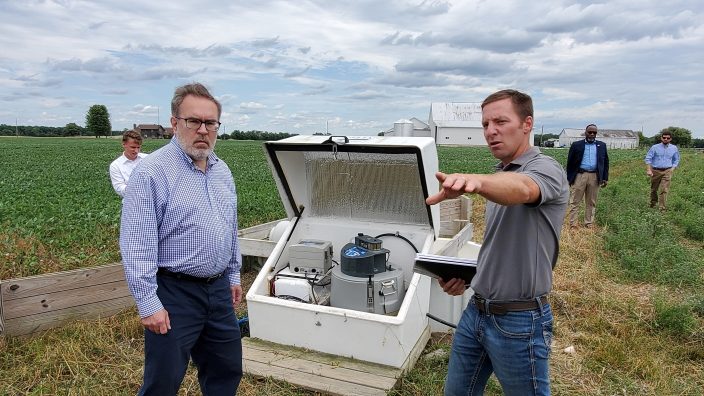Applications for Ohio Farm Bureau Health Plans now available
Members have three ways to apply: contacting a certified agent, calling 833-468-4280 or visiting ohiofarmbureauhealthplans.org.
Read MoreU.S. Environmental Protection Agency Administrator Andrew Wheeler recently visited the Blanchard River Demonstration Farms in northwest Ohio. Administrator Wheeler learned about all of the testing being done to improve water quality for the Western Lake Erie Basin and all of Ohio.
“It’s impressive to see how farmers are taking a proactive approach to try to reduce nutrient runoff,” Wheeler said. “Our agency is working cooperatively with farmers instead of hitting them with a hammer, and I think that farmers have proven that they know their land and they know what it takes to reduce phosphorus loading. These demonstration farms have shown me how they can save money on nutrients with new technologies while, at the same time, producing greater yields.”
The first stop for Wheeler was Kurt Farms in Dunkirk, Ohio. There, he learned about how edge-of-field testing units sample the water coming from farm fields to determine the volume of nutrients coming off of the farm and how different nutrient management practices impact the data.
Then, Wheeler traveled to Forest, Ohio to find out how larger-scale farmers Bill and Shane Kellogg are investing in new technologies and implements that allow them to only apply the nutrients needed with variable-rate equipment after reviewing analysis from soil samples taken from the farm.
“The Blanchard River Demonstration Farms are a great example of just how committed Ohio agriculture is to finding the best management practices for clean water,” said Adam Sharp, executive vice president of Ohio Farm Bureau. “The EPA is an important partner for continual water quality research, so we appreciate Administrator Wheeler coming to learn about the many different nutrient management approaches our demonstration farmers are taking and to discuss how efforts should move forward to protect natural resources across the state.”
The Blanchard River Demonstration Farms Network is a joint partnership between U.S. Department of Agriculture Natural Resources Conservation Services and the Ohio Farm Bureau Federation. The project is part of a Great Lakes Restoration Initiative designed to showcase and demonstrate leading edge conservation practices to improve Great Lakes water quality. Learn more at blancharddemofarms.org.
This is a news release for use by journalists. Questions should be directed to Ty Higgins, 614-246-8231 or [email protected].


Members have three ways to apply: contacting a certified agent, calling 833-468-4280 or visiting ohiofarmbureauhealthplans.org.
Read More

Bill Patterson, Cy Prettyman and Adele Flynn will continue to serve as officers for Ohio Farm Bureau Federation.
Read More

Delegates discussed many topics impacting agriculture including farmland preservation, local foods, and succession planning.
Read More

Twenty-six farmers govern the state’s largest farm and food organization.
Read More

The 2025 recipients are Fred Cooke (posthumous) of Richland County, Marvin Dietsch of Williams County, Steven Knollman of Hamilton County and Michele Miller (posthumous) of Ottawa County.
Read More

Nathan and Jill Parriman grow seasonal crops, including Christmas trees, pumpkins and cut flowers, providing U-cut experiences that invite customers to engage directly with agriculture.
Read More

The 2025 Distinguished Service Award recipients are Craig Adams, Mike Townsley, and Kellogg Farms, Kurt Farms and Stateler Family Farms.
Read More

Ohio Farm Bureau Treasurer Adele Flynn participated in the meeting, representing Ohio farmers.
Read More

For Ohio and PJM region, the outlook is reassuring—ample reserves and strong planning should keep the power on.
Read More

The average price for a classic holiday feast for 10 in Ohio will cost $55.87.
Read More